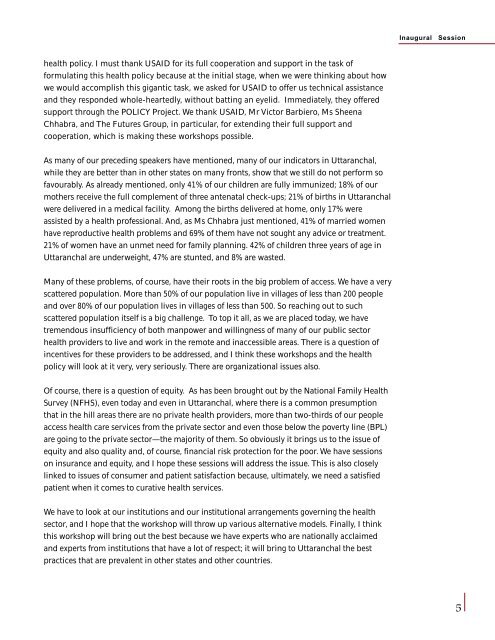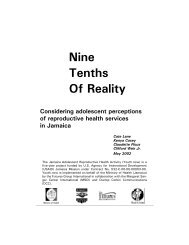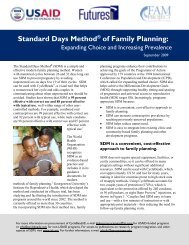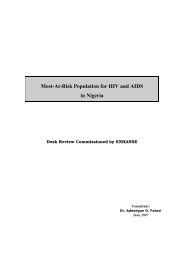Health Policy Issues and Health Programmes in ... - Amazon S3
Health Policy Issues and Health Programmes in ... - Amazon S3
Health Policy Issues and Health Programmes in ... - Amazon S3
- No tags were found...
You also want an ePaper? Increase the reach of your titles
YUMPU automatically turns print PDFs into web optimized ePapers that Google loves.
Inaugural Sessionhealth policy. I must thank USAID for its full cooperation <strong>and</strong> support <strong>in</strong> the task offormulat<strong>in</strong>g this health policy because at the <strong>in</strong>itial stage, when we were th<strong>in</strong>k<strong>in</strong>g about howwe would accomplish this gigantic task, we asked for USAID to offer us technical assistance<strong>and</strong> they responded whole-heartedly, without batt<strong>in</strong>g an eyelid. Immediately, they offeredsupport through the POLICY Project. We thank USAID, Mr Victor Barbiero, Ms SheenaChhabra, <strong>and</strong> The Futures Group, <strong>in</strong> particular, for extend<strong>in</strong>g their full support <strong>and</strong>cooperation, which is mak<strong>in</strong>g these workshops possible.As many of our preced<strong>in</strong>g speakers have mentioned, many of our <strong>in</strong>dicators <strong>in</strong> Uttaranchal,while they are better than <strong>in</strong> other states on many fronts, show that we still do not perform sofavourably. As already mentioned, only 41% of our children are fully immunized; 18% of ourmothers receive the full complement of three antenatal check-ups; 21% of births <strong>in</strong> Uttaranchalwere delivered <strong>in</strong> a medical facility. Among the births delivered at home, only 17% wereassisted by a health professional. And, as Ms Chhabra just mentioned, 41% of married womenhave reproductive health problems <strong>and</strong> 69% of them have not sought any advice or treatment.21% of women have an unmet need for family plann<strong>in</strong>g. 42% of children three years of age <strong>in</strong>Uttaranchal are underweight, 47% are stunted, <strong>and</strong> 8% are wasted.Many of these problems, of course, have their roots <strong>in</strong> the big problem of access. We have a veryscattered population. More than 50% of our population live <strong>in</strong> villages of less than 200 people<strong>and</strong> over 80% of our population lives <strong>in</strong> villages of less than 500. So reach<strong>in</strong>g out to suchscattered population itself is a big challenge. To top it all, as we are placed today, we havetremendous <strong>in</strong>sufficiency of both manpower <strong>and</strong> will<strong>in</strong>gness of many of our public sectorhealth providers to live <strong>and</strong> work <strong>in</strong> the remote <strong>and</strong> <strong>in</strong>accessible areas. There is a question of<strong>in</strong>centives for these providers to be addressed, <strong>and</strong> I th<strong>in</strong>k these workshops <strong>and</strong> the healthpolicy will look at it very, very seriously. There are organizational issues also.Of course, there is a question of equity. As has been brought out by the National Family <strong>Health</strong>Survey (NFHS), even today <strong>and</strong> even <strong>in</strong> Uttaranchal, where there is a common presumptionthat <strong>in</strong> the hill areas there are no private health providers, more than two-thirds of our peopleaccess health care services from the private sector <strong>and</strong> even those below the poverty l<strong>in</strong>e (BPL)are go<strong>in</strong>g to the private sector—the majority of them. So obviously it br<strong>in</strong>gs us to the issue ofequity <strong>and</strong> also quality <strong>and</strong>, of course, f<strong>in</strong>ancial risk protection for the poor. We have sessionson <strong>in</strong>surance <strong>and</strong> equity, <strong>and</strong> I hope these sessions will address the issue. This is also closelyl<strong>in</strong>ked to issues of consumer <strong>and</strong> patient satisfaction because, ultimately, we need a satisfiedpatient when it comes to curative health services.We have to look at our <strong>in</strong>stitutions <strong>and</strong> our <strong>in</strong>stitutional arrangements govern<strong>in</strong>g the healthsector, <strong>and</strong> I hope that the workshop will throw up various alternative models. F<strong>in</strong>ally, I th<strong>in</strong>kthis workshop will br<strong>in</strong>g out the best because we have experts who are nationally acclaimed<strong>and</strong> experts from <strong>in</strong>stitutions that have a lot of respect; it will br<strong>in</strong>g to Uttaranchal the bestpractices that are prevalent <strong>in</strong> other states <strong>and</strong> other countries.5







